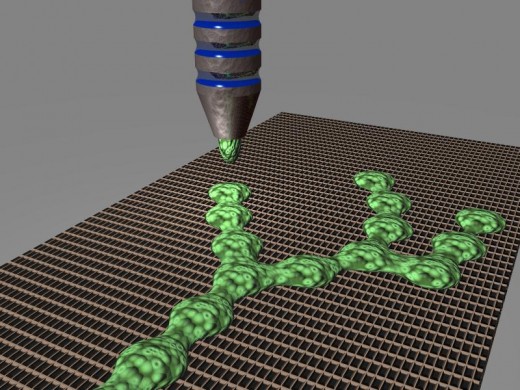Producing plants artificially
The illustration below shows a printing device printing a plant, using plant cells instead of ink.

In the future. plants may be produced by printers, that use plant cells instead of ink.
Plants may be produced in the future with a process I call agro-lithography. Agro-lithography is basically an adaptation of stereolithography. Stereolithography is a process that has been used for several years in industry for producing plastic parts. In stereolithography, a thermosetting liquid plastic is poured into a tank, and lasers are used to solidify it. The liquid plastic turns solid at any point where the lasers touch it. As the lasers build up layer upon layer of solid plastic, a plastic part is gradually formed. The process is so versatile, some people have compared it to printing, it's like printing plastic parts. Some have gone so far as to call the process 3-D printing. Suppose it were possible to use a liquid solution of plant cells instead of plastic, could a living plant be assembled, layer by layer, in a machine?
The word agro-lithography comes from the word 'agro', which means agricultural, and the word 'lithography', from the term stereolithography. An agro-lithography machine would basically be a printing machine that uses plant cells instead of ink to print a plant. The printer may print the plant on a piece of paper, since paper is a biodegradable material. Three different kinds of 'inks' may be used for printing a plant, first, root cells, then stem cells, then leaf cells. After the roots, stems, and leaves of the plant have been printed on a piece of paper, the piece of paper would be partially buried in the ground. The 'root' end of the page would be inserted into the ground, a few inches deep, so the roots can receive nutrients from the soil. The 'leaf' end of the page would be facing upwards so the leaves can receive light from the sun. After a few weeks, the leaves and stems of the plant should grow so large that they extend beyond the edges of the page they were printed on. Eventually, the piece of paper would rot away and disintegrate (since it's biodegradable) and only the plant would remain. The plant should grow normally after the paper substrate rots away.
To experiment with agro-lithography, we would start to produce plants on a small scale, and then work our way up to larger and larger plants. As we developed a means to produce larger plants, larger machines would be required. If we were going to print an entire tree, we would need a very large agro-lithography machine, perhaps as large as a ten-story-high building. To print a tree with an agricultural printer, first you would need to print a root system that was strong enough to support the weight of an entire tree above it. You would produce a ball of dirt, with cloth mesh wrapped around it, and then use the machine to print a set of tree roots around the ball of soil. Then you would add another layer of soil, wrapped in another layer of cloth mesh, and repeat the process. This process would be repeated until several layers of roots have been built up. After the root-ball has been created, it would be put into a hole in the ground, and an agro-lithography machine would be positioned above the hole. The agro-lithography machine would print a tree on top of the root-ball, first the trunk, then the branches, finally the leaves. After the tree was complete, the agro-lithography machine would be removed from the site. The tree should grow normally after that. In theory, any type of plant or tree could be produced with this method.



